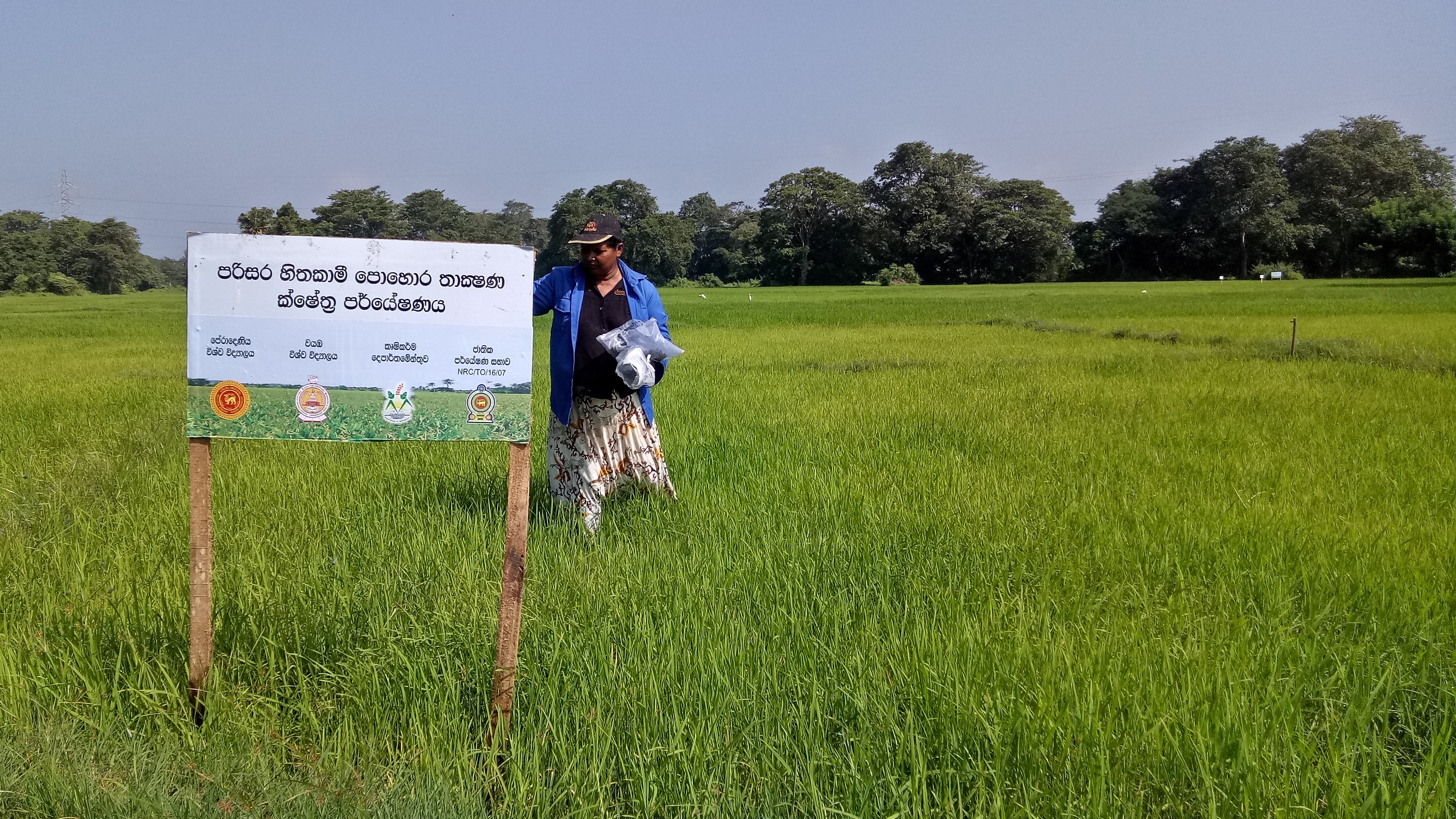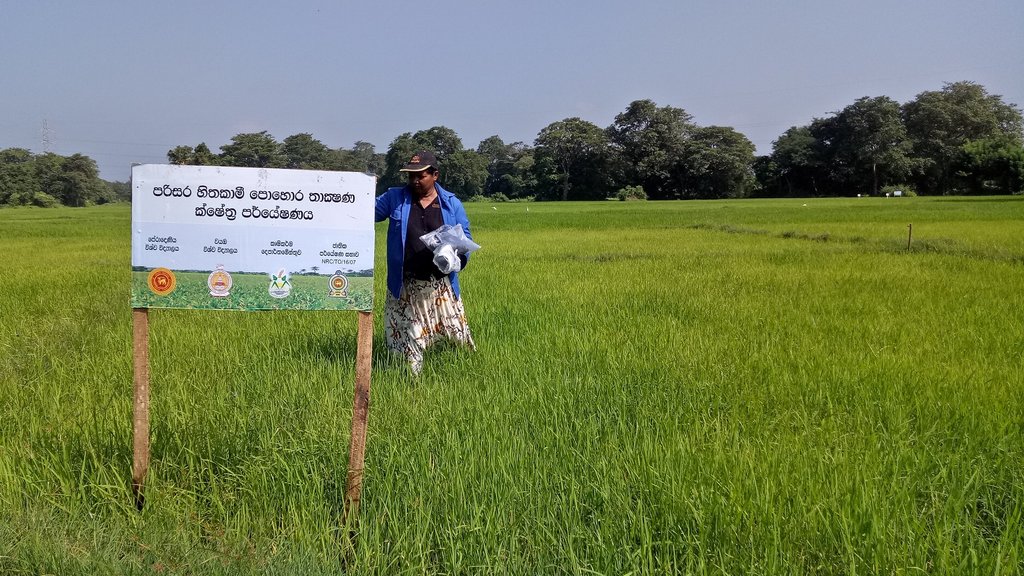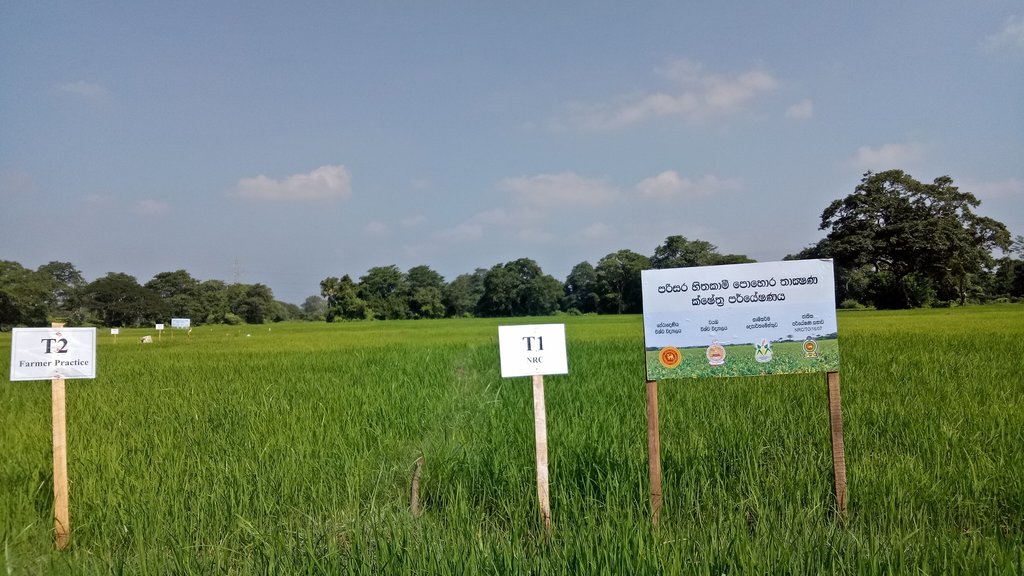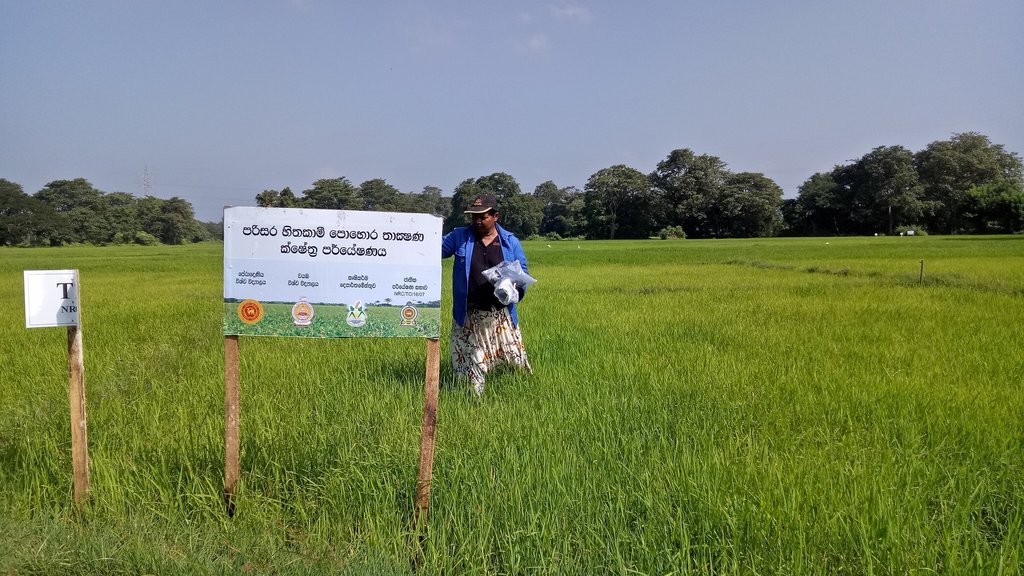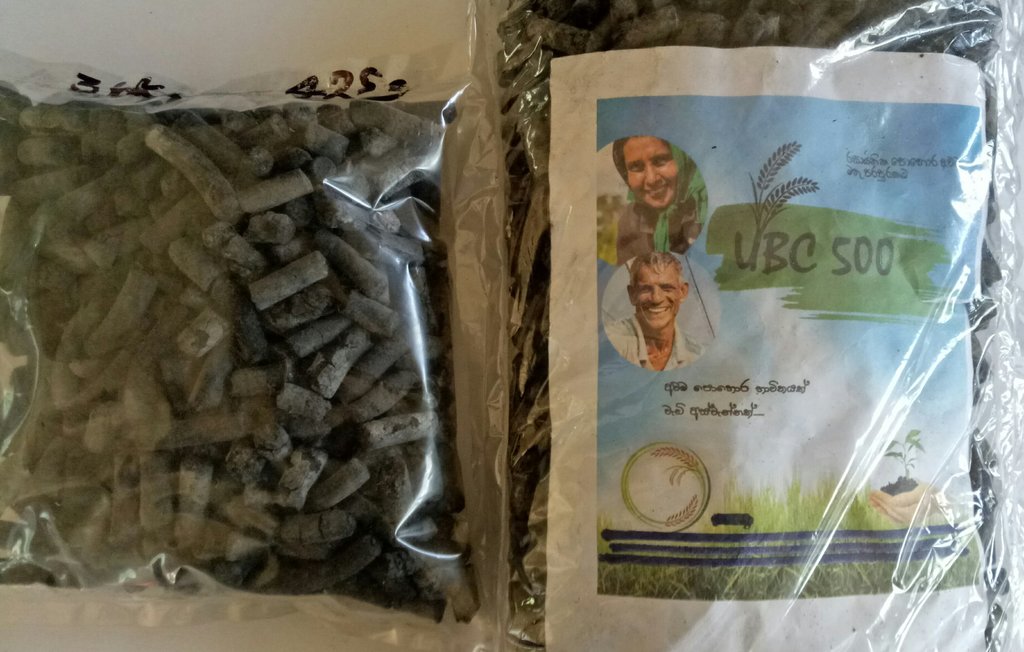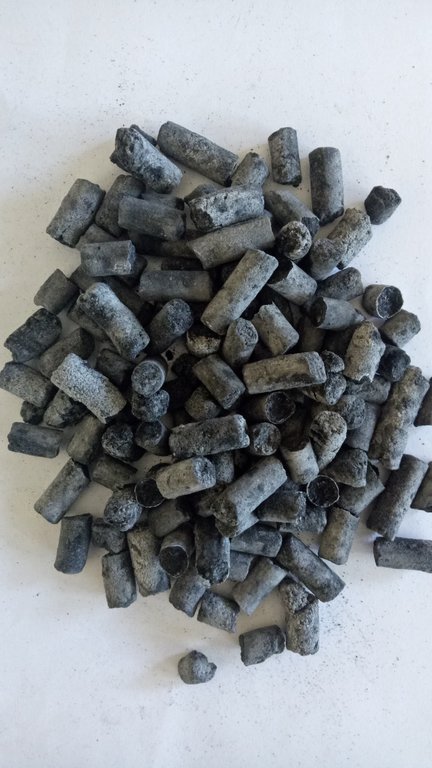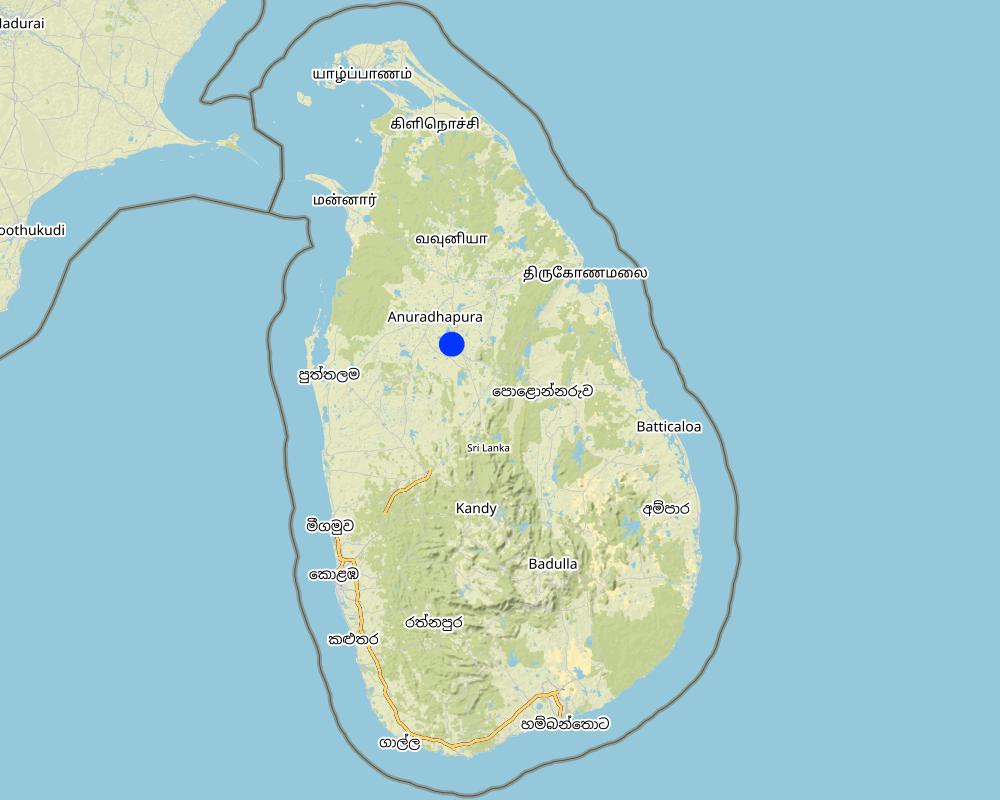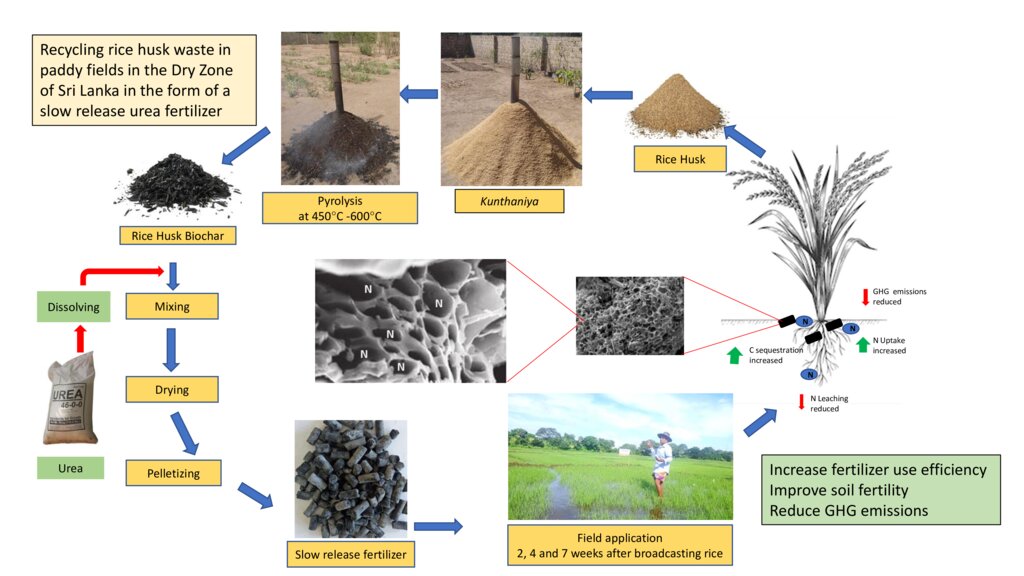Recycling rice husks in Sri Lanka as a biochar-based slow-release urea fertilizer [سريلانكا]
- تاريخ الإنشاء:
- تحديث:
- جامع المعلومات: Head Soil Science
- المحرر: –
- المراجعون: William Critchley, Rima Mekdaschi Studer
“anguru kata” pohora
technologies_6184 - سريلانكا
عرض الأقسام
توسيع الكل طي الكل1. معلومات عامة
1.2 تفاصيل الاتصال بالأشخاص الرئيسيين لمصدر المعلومات والمؤسسات المشاركة في تقييم وتوثيق التقنية
الشخص (الأشخاص) الرئيسي لمصدر المعلومات
متخصص في الإدارة المستدامة للأراضي:
Dissanayaka Lakmini
Coconut Research Institute
سريلانكا
مستخدم الأرض:
Senarathna Renuka
سريلانكا
مستخدم الأرض:
Nandasena Lekam Ralalage
سريلانكا
مستخدم الأرض:
Kirihamige Vimalawathi
سريلانكا
جامع المعلومات المشارك:
Dharmakeerthi Saman
University of Peradeniya
سريلانكا
جامع المعلومات المشارك:
اسم المؤسسة (المؤسسات) التي سهلت توثيق/تقييم التقنية (إذا كان ذلك على صلة)
Faculty of Agriculture, University of Peradeniya, Sri Lanka (AGRI.PDN) - سريلانكا1.3 الشروط المتعلقة باستخدام البيانات الموثقة من خلال WOCAT
يوافق جامع المعلومات والشخص (لاشخاص) الرئيسي لمصدر المعلومات على الشروط المتعلقة باستخدام البيانات الموثقة من خلال WOCAT:
نعم
1.4 إعلان بشأن استدامة التقنية الموصوفة
هل التقنية الموصوفة هنا تمثل مشكلة فيما يتعلق بتدهور الأراضي، بحيث لا يمكن إعلانها تقنية مستدامة لإدارة الأراضي؟:
كلا
التعليقات:
Urea is the type of nitrogen fertilizer available in Sri Lanka. Urea is readily soluble in water and hydrolyses to ammonia which in turn is converted to nitrate by microorganisms. Nitrate can be lost by leaching, volatilization, and denitrification in paddy fields. However, slow release fertilizer (SRF) releases the N in urea slowly to the soil and allows efficient uptake by the crop at the right time. Hence, it reduces the negative environmental impacts associated with N losses and also maintains adequate productivity in rice cultivation. In addition, this technology reduces CO2 emissions from rice husks to the atmosphere.
2. وصف تقنيةالإدارة المستدامي للأراضي
2.1 وصف مختصر للتقنية
تعريف التقنية:
Rice husks, a waste product generated in rice mills, can release its carbon as a greenhouse gas (GHG) to the atmosphere through burning or decomposition. Converting it into biochar and intercalating (filled) with urea can produce a slow-release nitrogen (N) fertiliser that improves N-use efficiency while minimizing GHG emissions.
2.2 وصف تفصيلي للتقنية
الوصف:
Rice husks are often considered as a waste, and its carbon is released to the atmosphere as carbon dioxide (CO2) which is a greenhouse gas (GHG) through either decomposition or burning as a biofuel. However, rice husks can be converted into biochar – where its carbon is stable - with a large number of micro and sub-micron size pores in a honeycomb-like structure. Rice husk biochar was produced using an improved batch pyrolizer, “Kunthaniya”, at a temperature of between 450°C and 650°C. Pore spaces in rice husk biochar can be intercalated (filled) with urea and then, slow-release fertilizer (SRF) pellets can be produced through the use of a suitable biodegradable binder. This SRF has found to be more efficient in improving the N-use efficiency, hence the urea requirement of paddy fields in Sri Lanka can be reduced by about 25%, further contributing to environment sustainability. It has been well documented that biochar can improve soil physical, chemical and biological properties in a sustainable manner. This process is a contribution to creative recycling of agricultural waste.
The SRF technology was evaluated against current farmer practice in rice cultivated area in Mahakanumulla village, Anuradhapura district, Sri Lanka. The area belongs to the Dry Zone of Sri Lanka (mean annual rainfall <1750mm). Rice is cultivated during two seasons, yala (May-September) and maha (December – February): the yala season is generally drier. Farmers rely on irrigation water supplied from a small village tank. The SRF was transported to farmers’ fields and applied at 2 weeks (@ 100 kg/ha), at 4 weeks (@ 170 kg/ha) and 7 weeks (@ 145 kg/ha) after direct seeding.
Farmers indicated that the granule size was large and light, hence they had some concerns about even distribution of fertilizer. They perceive that plants receive N slowly compared to granular urea - suggesting the slow releasing nature of the new technology. They did not observe any yield difference. Obtaining rice husks in large quantities from rice mills to produce biochar can sometimes be difficult in some areas of the country due to competition for use in the poultry industry. Some farmers may be discouraged to implement this technology due to lack of knowledge: this can be overcome through extension officers operating at field level.
This new technology qualifies as a sustainable land management practice in number of ways. First it increases N-use efficiency in paddy fields, second it reduces the urea requirement by 25% while sustaining productivity, third it recycles agricultural wastes in paddy fields, fourth, repeated application of SRF improves soil fertility through rice husk biochar, and finally it reduces GHG emissions.
2.3 صور التقنية
ملاحظات عامة بخصوص الصور:
The photos show the application of SRF on farmers fields and the physical nature of the SRF.
2.5 البلد/المنطقة/المواقع التي تم تنفيذ التقنية فيها والتي يغطيها هذا التقييم
البلد:
سريلانكا
المنطقة/الولاية/المحافظة:
North Central Province
مزيد من التفاصيل حول الموقع:
Mahakanumulla village, Thirappane
حدد انتشار التقنية:
- يتم تطبيقها في نقاط محددة/ تتركز على مساحة صغيرة
هل يقع موقع/مواقع التقنية في منطقة محمية بشكل دائم؟:
كلا
Map
×2.6 تاريخ التنفيذ
اذكر سنة التنفيذ:
2021
2.7 إدخال التقنية
حدد كيف تم إدخال التقنية:
- أثناء التجارب/الأبحاث
- من خلال المشاريع/ التدخلات الخارجية
3. تصنيف تقنية الإدارة المستدامي للأراضي
3.1 الغرض الرئيسي ( الأغراض الرئيسية) للتقنية
- تحسين الإنتاج
- الحد من تدهور الأراضي ومنعه وعكسه
- التخفيف من تغير المناخ وآثاره
- خلق أثر اقتصادي مفيد
- خلق أثر اجتماعي مفيد
3.2 نوع (أنواع) استخدام الأراضي الحالية حيث يتم تطبيق التقنية
استخدامات الأراضي مختلطة ضمن نفس وحدة الأرض:
كلا

الأراضي الزراعية
- زراعة سنوية
الزراعة السنوية - حدد المحاصيل:
- الحبوب - الأرز (الأراضي الرطبة)
نظام زراعة سنوي:
زراعة مستديمة لأرز الأراضي الرطبة
عدد مواسم الزراعة في السنة:
- 2
حدد:
yala and maha seasons
هل يتم ممارسة الزراعة البينية؟:
كلا
هل تتم ممارسة تناوب المحاصيل؟:
كلا
3.3 هل تغير استخدام الأراضي نتيجة لتنفيذ التقنية؟
هل تغير استخدام الأراضي نتيجة لتنفيذ التقنية؟:
- لا (تابع مع السؤال 3.4)
3.4 إمدادات المياه
إمدادات المياه للأرض التي يتم تنفيذ التقنية عليها:
- مختلط بعلي-مروي
التعليقات:
Rice farmers in Mahakanumulla mainly depend on irrigation water supplied from a small tank located above the rice fields. However, farmers do not irrigate rice fields if they receive adequate rainfall. But, increasingly, farmers depend on irrigation water due to decreasing rainfall during the growing season.
3.5 مجموعةالإدارة المستدامة للأراضي التي تنتمي إليها هذه التقنية
- الإدارة المتكاملة لخصوبة التربة
- إدارة النفايات / إدارة مياه الصرف الصحي
3.6 التدابير التقنية في مجال إلادارة المستدامة للأراضي

التدابير الزراعية
- A2: المادة العضوية/خصوبة التربة
- A3: معالجة سطح التربة
- A6: إدارة المخلفات
A3: التمييز بين أنظمة الحراثة:
A 3.3: Full tillage (< 30% soil cover)
A6:حدد إدارة المخلفات:
A 6.4:تم الاحتفاظ بها
التعليقات:
Application of SRF to the crop at the required growth stages to improve the soil fertility and, thus, crop productivity.
3.7 الأنواع الرئيسية من تدهور الأراضي التي تناولتها التقنية

التدهور الكيميائي للتربة
- (Cn): تراجع الخصوبة وانخفاض محتوى المادة العضوية (غير ناتج عن الانجراف)
- (Cp): تلوث التربة

تدهور المياه
- (Hp): تدهور نوعية المياه السطحية
- (Hq): تدهور نوعية المياه الجوفية
التعليقات:
The SRF technology improves soil fertility by reducing nitrogen (N) loss from the soil due to leaching. And it also reduces accumulation of excess N in surface and ground water bodies, preventing water pollution.
3.8 منع أو حد أو عكس تدهور الأراضي
تحديد هدف التقنية فيما يتعلق بتدهور الأراضي:
- الحد من تدهور الأراضي
التعليقات:
The use of conventional N fertilizers to cultivate rice for a long period of time causes higher N losses from the soil and results a potential risk of environment pollution. Application as an SRF reduces the losses of N from the soil, increases crop nutrient uptake and increases crop productivity. The reduced losses mitigate soil fertility degradation and deterioration of water quality.
4. المواصفات الفنية، وأنشطة التنفيذ، والمدخلات، والتكاليف
4.1 الرسم الفني للتقنية
المواصفات الفنية (المتعلقة بالرسم الفني):
Production of SRF: Rice husks were pyrolyzed using a locally modified “Kunthaniya” (a batch pyrolyser) to produce rice husk biochar. The temperature of the pyrolyser was around 450°C to 600°C with a heating rate of less than 20°C per hour. Pore structures were saturated using a urea solution through capillary action. The urea-intercalated rice husk biochar is then mixed with a biodegradable organic substance and pelletized using a medium scale pelletizer and dried to increase its mechanical properties such as resistance to disintegration and shear forces.
Field Experiment : Five paddy farmers were randomly selected from the command area of a small tank in the Mahakanumulla Village Tank Cascade System in the Dry Zone of Sri Lanka. The produced SRF was applied at a rate of 75% of recommended N in three split applications. Yields in SRF applied areas were compared against the current farmer practice. Experimental evidence showed that there is no yield reduction despite the reduction of nitrogen input into their fields.
المؤلف:
H.P.G.T.N. Kulasinghe
4.2 معلومات عامة بخصوص حساب المدخلات والتكاليف
حدد كيفية احتساب التكاليف والمدخلات:
- حسب مساحة تنفيذ التقنية
الإشارة إلى حجم ووحدة المساحة:
1ha
عملة أخرى/ عملة وطنية (حدد):
LKR
إذا كان ذا صلة، وضح سعر الصرف من الدولار الأمريكي إلى العملة المحلية (على سبيل المثال، 1 دولار أمريكي = 79.9 ريال برازيلي): 1 دولار أمريكي =:
275,0
اذكر متوسط تكلفة أجر العمالة المستأجرة في اليوم الواحد:
1500
4.3 أنشطة التأسيس
| النشاط | التوقيت (الموسم) | |
|---|---|---|
| 1. | Collection of paddy husk from rice milling stations | 2 months before cultivation |
| 2. | Pyrolyzing of paddy husk using a pyrolizer or a kunthani | 6 weeks before cultivation |
| 3. | Mixing with urea, ERP and other ingredients and pelletizing | 4 weeks before cultivation |
| 4. | Drying the pellets (SRF) | 2 weeks before cultivation |
| 5. | Packing and transporting SRF to the rice fields | 1 week before cultivation |
التعليقات:
One of the major raw materials to produce SRF is rice husks and it can be supplied from rice milling stations, generally available year-round. However, there is competition for rice husks in the market because of demand from the poultry industry. Hence, finding rice husks is sometimes difficult in some areas of the country.
4.4 التكاليف والمدخلات اللازمة للتأسيس
| تحديد المدخلات | الوحدة | الكمية | التكاليف لكل وحدة | إجمالي التكاليف لكل مدخل | % من التكاليف التي يتحملها مستخدمو الأراضي | |
|---|---|---|---|---|---|---|
| العمالة | Manufacturing SRF | Labour days | 2,5 | 1500,0 | 3750,0 | |
| الأسمدة والمبيدات الحيوية | Urea | kg | 200,0 | 270,0 | 54000,0 | |
| مواد البناء | Binding materials 1 | kg | 10,0 | 25,0 | 250,0 | |
| مواد البناء | Binding materials 2 | kg | 10,0 | 250,0 | 2500,0 | |
| مواد البناء | Rice husk biochar | kg | 200,0 | 50,0 | 10000,0 | |
| إجمالي تكاليف إنشاء التقنية | 70500,0 | |||||
| إجمالي تكاليف إنشاء التقنية بالدولار الأمريكي | 256,36 | |||||
إذا تحمل مستخدم الأرض أقل من 100% من التكاليف، حدد من قام بتغطية التكاليف المتبقية:
Project funded by the National Research Council of Sri Lanka (Grant No. : NRC TO-16/07)
التعليقات:
SRF was given to the farmer, free, for application. The cost of SRF was borne by the project funded by the National Research Council of Sri Lanka (Grant No. : NRC TO-16/07)
4.5 الصيانة/الأنشطة المتكررة
| النشاط | التوقيت/الوتيرة | |
|---|---|---|
| 1. | Application of first dose of SRF | 2 weeks after direct seeding of rice |
| 2. | Application of second dose of SRF | 4 weeks after direct seeding of rice |
| 3. | Application of third dose of SRF | 7 weeks after direct seeding of rice |
التعليقات:
Application of correct amount of SRF at the correct growth stage of the rice crop is important for efficient uptake of N to the crop and reduce losses.
4.6 التكاليف والمدخلات اللازمة للصيانة/للأنشطة المتكررة (سنويًا)
| تحديد المدخلات | الوحدة | الكمية | التكاليف لكل وحدة | إجمالي التكاليف لكل مدخل | % من التكاليف التي يتحملها مستخدمو الأراضي | |
|---|---|---|---|---|---|---|
| العمالة | Labour for SRF application | Labour days | 3,0 | 1500,0 | 4500,0 | 100,0 |
| إجمالي تكاليف صيانة التقنية | 4500,0 | |||||
| إجمالي تكاليف صيانة التقنية بالدولار الأمريكي | 16,36 | |||||
4.7 أهم العوامل المؤثرة على التكاليف
قدم وصفا لأهم العوامل التي تؤثر على التكاليف:
Labour availability and finding raw materials are the major factors that affect the cost.
5. البيئة الطبيعية والبشرية
5.1 المناخ
هطول الأمطار السنوي
- < 250 مم
- 251- 500 ملم
- 501 - 750ملم
- 1,000-751 ملم
- 1,500-1,100 ملم
- 2,000-1,500 ملم
- 3,000-2,001 ملم
- 4,000-3,100 ملم
- > 4000 ملم
حدد متوسط هطول الأمطار السنوي (إذا كان معروفًا)، بالملليمتر:
1400,00
المواصفات/التعليقات على هطول الأمطار:
The Mahakanumulla area receives monsoon rainfall during two distinct seasons, namely yala (May – September) and maha (December – February), hence a bimodal rainfall pattern can be observed. The highest amount of rainfall is received during the maha season, in which most of the rainfall comes from the North-eastern monsoonal rains. Lesser rainfall is received from the South-west monsoonal rains, during the yala season. Hence prolonged dry periods are observed during the yala season. Other than that, this area receives rainfall from two inter-monsoonal rains (March-April and October-November).
الإشارة إلى اسم محطة الأرصاد الجوية المرجعية المعنية:
Mahailuppallama, Anuradhapura
المنطقة المناخية الزراعية
- شبه قاحلة
Recorded minimum and maximum temperatures in the area are 20.8°C and 29.5°C respectively
5.2 طوبوغرافيا
متوسط الانحدارات:
- مسطح (0-2%)
- بسيط (3-5%)
- معتدل (6-10%)
- متدحرج (11-15%)
- تلال (16-30%)
- شديدة الانحدار(31-60%)
- فائقة الانحدار (>60%)
التضاريس:
- هضاب/سهول
- أثلام مرتفعة
- المنحدرات الجبلية
- منحدرات التلال
- منحدرات في السفوح
- قاع الوادي
المنطقة الارتفاعية:
- 100-0 متر فوق سطح البحر
- 500-101 متر فوق سطح البحر
- 1,000-501 متر فوق سطح البحر
- 1,500-1,001 متر فوق سطح البحر
- 2,000-1,501 متر فوق سطح البحر
- 2,500-2,100 متر فوق سطح البحر
- 3,000-2,501 متر فوق سطح البحر
- 4,000-3,001 متر فوق سطح البحر
- > 4000 متر فوق سطح البحر
وضح ما إذا كانت التقنية مطبقة على وجه التحديد في:
- غير ذات صلة
التعليقات والمواصفات الإضافية بشأن التضاريس:
The altitude of the area is 112m. An undulating pattern of topography is a distinct feature of this landscape. The rice is cultivated mainly in the valley area of the catena and other upland crops are cultivated in the crest area of the catena.
5.3 التربة
متوسط عمق التربة:
- ضحل جدًا (0-20 سم)
- ضحلة (21-50 سم)
- متوسطة العمق (51-80 سم)
- عميقة (81-120 سم)
- عميقة جدًا (> 120 سم)
قوام التربة (التربة السطحية):
- خشن / خفيف (رملي)
قوام التربة (> 20 سم تحت السطح):
- متوسط ( طميي، سلتي)
المواد العضوية في التربة السطحية:
- متوسطة (1-3%)
إذا كان متاحًا، قم بإرفاق وصف كامل للتربة أو تحديد المعلومات المتوفرة، على سبيل المثال نوع التربة، الرقم الهيدروجيني/ درجة حموضة التربة، قدرة التبادل الكاتيوني، النيتروجين، الملوحة وما إلى ذلك.
Rice growing soils of the Mahakanumulla area are classified as Alfisols (Typic endoaquaalf). The soil is poorly drained. The pH of the soil is in the neutral range (6.05-7.23). Soil EC (55.5-143.0 µs/cm, 1:2.5 soil:water) values did not show any occurrence of soil salinity. Av. P content of the soil (Olsen P) was low for rice growth (<5 mg/kg) and ranged from 2.9-3.5 mg/kg. Av. K content of the soils was medium to high for rice growth and ranged from 61.3-99 mg/kg.
5.4 توافر المياه ونوعيتها
منسوب المياه الجوفية:
< 5 م
توافر المياه السطحية:
جيد
نوعية المياه (غير المعالجة):
للاستخدام الزراعي فقط (الري)
تشير جودة المياه إلى:
المياه الجوفية والسطحية
هل تعتبر ملوحة الماء مشكلة؟:
كلا
هل تحدث فيضانات في المنطقة؟:
كلا
تعليقات ومواصفات أخرى بشأن نوعية المياه وكميتها:
The amount of water supplied through the irrigation is limited during the dry season (yala). The water quality is affected by soil macro-nutrients (N, P, K) added as fertilizers to the soil. Due to the undulating topography of the landscape, those soil nutrients can wash-off from higher positions to lower positions due to surface runoff and leaching into the ground water and accumulating in the water bodies in the lower positions of the catena.
5.5 التنوع البيولوجي
تنوع الأنواع:
- متوسط
تنوع الموائل:
- متوسط
التعليقات والمواصفات الإضافية بشأن التنوع البيولوجي:
Number of different tree species, wild animals, birds, insects and aquatic life can be observed around Mahakanumulla village. Forest patches can be identified mostly around the small tank, and those areas are habitats for multiple wild animals and birds.
5.6 خصائص مستخدمي الأراضي الذين يطبقون التقنية
مستقر أو مرتحل:
- غير المترحل
التوجه السوقي لنظام الإنتاج:
- مختلط (كفاف/ تجاري)
الدخل من خارج المزرعة:
- 10-50% من جميع الإيرادات
المستوى النسبي للثروة:
- ضعيف
أفراداً أو مجموعات:
- فرد/أسرة معيشية
مستوى المكننة:
- عمل يدوي
- ميكانيكية/ مزودة بمحرك
الجنس:
- نساء
- رجال
عمر مستخدمي الأرضي:
- متوسط العمر
اذكر الخصائص الأخرى ذات الصلة لمستخدمي الأراضي:
Most of the land users are dependent on full time rice farming. But some land users use rice farming as a secondary source of income and do other jobs in the city. Most of the younger generation in the village are migrating for jobs in the cities.
5.7 متوسط مساحة الأرض التي يستخدمها مستخدمو الأراضي الذين يطبقون التقنية
- < 0.5 هكتارا
- 0.5 - 1 هكتار
- 1 -2 هكتار
- 2 - 5 هكتار
- 5 - 15 هكتار
- 15 - 50 هكتار
- 50 - 100هكتار
- 500-100 هكتار
- 1,000-500 هكتار
- 10,000-1,000 هكتار
- > 10,000 هكتار
هل يعتبر هذا نطاقًا صغيرًا أو متوسطًا أو واسعا (في إشارة إلى السياق المحلي)؟:
- على نطاق صغير
التعليقات:
Rice is cultivated over a large area. However, single farmer manage relatively small fields (0.5-1 ha or 2-5 ha). The fields managed by farmers are located adjacent to each other.
5.8 ملكية الأراضي، وحقوق استخدام الأراضي، وحقوق استخدام المياه
ملكية الارض:
- فردية، يوجد سند ملكية
حقوق استخدام الأراضي:
- فردي
حقوق استخدام المياه:
- مجتمعي (منظم)
هل تعتمد حقوق استخدام الأراضي على نظام قانوني تقليدي؟:
كلا
5.9 الوصول إلى الخدمات والبنية التحتية
الصحة:
- ضعيف
- معتدل
- جيد
التعليم:
- ضعيف
- معتدل
- جيد
المساعدة التقنية:
- ضعيف
- معتدل
- جيد
العمل (على سبيل المثال خارج المزرعة):
- ضعيف
- معتدل
- جيد
الأسواق:
- ضعيف
- معتدل
- جيد
الطاقة:
- ضعيف
- معتدل
- جيد
الطرق والنقل:
- ضعيف
- معتدل
- جيد
مياه الشرب وخدمات الصرف الصحي:
- ضعيف
- معتدل
- جيد
الخدمات المالية:
- ضعيف
- معتدل
- جيد
التعليقات:
The villagers of Mahaknumulla have access for most of the resources like infrastructure and energy/electricity/fuel. But most of the villagers/landusers complain about technical assistant/support for agricultural practices, finding markets for their produce and availability of good quality drinking water. The villagers go to nearby shops to buy day-to-day needs, but they have to go to the town, which is 8-10km away, for other services such as health and financial services.
6. الآثار والتصريحات الختامية
6.1 الآثار التي أظهرتها التقنية في الموقع
الآثار الاجتماعية والاقتصادية
الإنتاج
إنتاج المحاصيل
الكمية قبل الإدارة المستدامة للأراضي:
6.5 t/ha (two seasons)
الكمية بعد الإدارة المستدامة للأراضي:
6.9 t/ha (two seasons)
التعليقات/ حدد:
Although farmers could not observe a yield increase , experimental evidence suggests upto10% yield increase compared to farmer fertilizer management. A decrease in yield however not observed by farmers despite 25% reduction in N input. The above figures are for average of five farmers over two seasons.
جودة المحاصيل
خطر فشل الإنتاج
تنوع المنتج
منطقة الإنتاج
إدارة الأراضي
توافر المياه ونوعيتها
توافر مياه الشرب
نوعية مياه الشرب
توافر المياه للماشية
نوعية المياه للماشية
توافر مياه الري
نوعية مياه الري
الطلب على مياه الري
الدخل والتكاليف
النفقات على المدخلات الزراعية
الكمية قبل الإدارة المستدامة للأراضي:
LKR 60,750.00/ha for urea
الكمية بعد الإدارة المستدامة للأراضي:
LKR 70,500/ha for SRF
التعليقات/ حدد:
LKR 270/kg urea and LKR 167/kg of SRF. Expenses were calculated assuming all other costs are constants under two situations
دخل المزرعة
الكمية قبل الإدارة المستدامة للأراضي:
LKR 520,000/ha
الكمية بعد الإدارة المستدامة للأراضي:
LKR 552,000/ha
التعليقات/ حدد:
LKR 80/kg of paddy. Average yields mentioned above was used to calculate the farm income. Therefore, farm income is expected to be increased more than the expenses in SRF applied fields.
تنوع مصادر الدخل
فروقات اقتصادية
عبء العمل
التعليقات/ حدد:
Although a longer time is required for SRF application because of higher bulk volume (175kg more), this application cost is negligible
الآثار الاجتماعية والثقافية
الأمن الغذائي / الاكتفاء الذاتي
التعليقات/ حدد:
Expected improvements in productivity due to SRF application could strengthen the food security
الوضع الصحي
استخدام الأراضي / حقوق المياه
الفرص الثقافية
الفرص الترفيهية
المؤسسات المجتمعية
المؤسسات الوطنية
المعرفة بالإدارة المستدامة للأراضي/تدهور الأراضي
التعليقات/ حدد:
Farmers gain awareness through extension programmes when implementing the SRF technology
التخفيف من حدة الصراع
وضع الفئات المحرومة اجتماعيا واقتصاديا
الآثار الايكولوجية
دورة المياه / الجريان السطحي
كمية المياه
جودة المياه
التعليقات/ حدد:
N accumulation in water bodies is reducing due to lower N losses of SRF
حصاد / جمع المياه
الجريان السطحي
تصريف المياه الزائدة
مستوى المياه الجوفية/ الطبقة المائية الجوفية
التبخر
التربة
رطوبة التربة
التعليقات/ حدد:
It is expected to have a better moisture content as a result of accumulation of biochar with repeated application of SRF
غطاء التربة
التعليقات/ حدد:
Experimental evidence suggests that soil cover is more with rice plants that grow better and tiller more due to better N utilization for crop growth
فقدان التربة
تراكم التربة
تكون قشرة التربة السطحية/انسداد مسام التربة
تراص التربة
دورة المغذيات/إعادة الشحن
الكمية قبل الإدارة المستدامة للأراضي:
N uptake: 167 kg of N/ha
الكمية بعد الإدارة المستدامة للأراضي:
N uptake: 219 kg of N/ha
التعليقات/ حدد:
Higher uptake of N by rice plants due to SRF application, nutrient recycling is expected to be improved. The above values were obtained from 5 farmer fields in the year 2021.
الملوحة
الكمية قبل الإدارة المستدامة للأراضي:
Electrical Conductivity : 0.11 dS/m
الكمية بعد الإدارة المستدامة للأراضي:
Electrical Conductivity : 0.09 dS/m
التعليقات/ حدد:
The above values were obtained from 5 farmer fields in the year 2021.
المادة العضوية في التربة/تحت الطبقة c
التعليقات/ حدد:
SRF contains biochar which is a good source to improve the soil C.
الحموضة
الكمية قبل الإدارة المستدامة للأراضي:
pH : 7.42
الكمية بعد الإدارة المستدامة للأراضي:
pH : 7.38
التعليقات/ حدد:
The above values were obtained from 5 farmer fields in the year 2021.
التنوع البيولوجي: الغطاء النباتي، الحيوانات
الغطاء النباتي
التعليقات/ حدد:
Efficient uptake of N cause to improve the crop growth, thereby vegetation cover
الكتلة الحيوية/ طبقة الكربون فوق التربة
الكمية قبل الإدارة المستدامة للأراضي:
5.2 t/ha (straw) + 8.1 (grain)
الكمية بعد الإدارة المستدامة للأراضي:
6.0 t/ha (straw) + 8.7 t/ha (grain)
التعليقات/ حدد:
Higher crop growth results higher biomass production. The above values were obtained from 5 farmer fields in the year 2021.
التنوع النباتي
الأنواع الدخيلة الغازية
التنوع الحيواني
الأنواع المفيدة
تنوع الموائل
مكافحة الآفات/الأمراض
الحد من مخاطر المناخ والكوارث
آثار الفيضانات
انزلاقات أرضية / تدفقات الحطام
آثار الجفاف
آثار السيكلون والعواصف المطرية
انبعاث الكربون والغازات المسببة للاحتباس الحراري
خطر الحريق
سرعة الرياح
المناخ الموضعي (مايكرو)
التعليقات/ حدد:
Because of the better growth of the rice plants micro climate in the paddy fields is expected to be improved.
حدد تقييم الآثار في الموقع (القياسات):
Plant growth parameters and yield
6.2 الآثار التي أظهرتها التقنية خارج الموقع
توافر المياه
تدفقات مائية موثوقة ومستقرة في موسم الجفاف
الفيضان في اتجاه مجرى النهر
تراكم الطمي باتجاه مصب النهر
تلوث المياه الجوفية/الأنهار
التعليقات/ حدد:
N accumulation in water bodies is expected to be reduced due to lower N losses from SRF
القدرة على التخفيف / الترشيح
الرواسب المنقولة بواسطة الرياح
الأضرار التي لحقت بحقول الجيران
الضرر على البنية التحتية العامة/ الخاصة
آثار الغازات الدفيئة
6.3 تعرض التقنية وحساسيتها لتغير المناخ التدريجي والظواهر المتطرفة/الكوارث المرتبطة بالمناخ (كما يراها مستخدمو الأراضي)
تغير مناخ تدريجي
تغير مناخ تدريجي
| الموسم | زيادة أو نقصان | كيف تتعامل التقنية مع ذلك؟ | |
|---|---|---|---|
| درجة الحرارة السنوية | زيادة | غير معروف | |
| هطول الأمطار السنوي | انخفاض | غير معروف |
6.4 تحليل التكلفة والعائد
كيف يمكن مقارنة العوائد نسبة لتكاليف الإنشاء (من وجهة نظر مستخدمي الأراضي)؟
عوائد قصيرة الأجل:
محايد/متوازن
عوائد طويلة الأجل:
إيجابي قليلا
كيف تتم مقارنة العوائدمع كلفة الصيانة/التكاليف المتكررة (من وجهة نظر مستخدمي الأراضي)؟
عوائد قصيرة الأجل:
إيجابي
عوائد طويلة الأجل:
إيجابي قليلا
6.5 اعتماد التقنية
- حالات فردية/تجريبية
إذا كان متاحًا، قم بتحديد الكمية (عدد الأسر المعيشية و/أو المساحةالمغطاة):
5 farmers/households
6.6 التكيف
هل تم تعديل التقنية مؤخرًا لتتكيف مع الظروف المتغيرة؟:
كلا
6.7 نقاط القوة / المزايا / الفرص التي توفرها التقنية
| نقاط القوة/ المزايا/ الفرص من وجهة نظر مستخدمي الأراضي |
|---|
| This technology uses less chemical fertilizer and therefore it is good for their health and environment |
| This technology gives better crop growth and slightly higher yield |
| Biochar could improve the fertility of the soil |
| نقاط القوة/ المزايا/ الفرص من وجهة نظر جامع المعلومات أو غيره من الاشخاص الرئيسيين لمصدر المعلومات |
|---|
| SRF reduces the N losses from the soil and allows the rice crop to uptake N effectively from soil at required growth stages. Efficient N uptake promotes the crop growth and increase the productivity. |
| Reduced N losses of SRF directly influence the water quality by reducing the losses of N through surface runoff and leaching and avoid accumulation in water bodies at the lower positions of the landscape. |
| Rice husks, which is are good source of C, are utilized for SRF production; hence it promotes C sequestration as it is added back to the soil as biochar. It improves the soil organic carbon pool and promotes carbon sequestration in soil. |
| Utilizing rice husks by returning back to the rice fields is an effective solution for rice waste management. |
| If the SRF production technology can be transferred to farmers, their societies can produce the SRF by themselves from the wastes generated in small scale rice mills. |
6.8 نقاط ضعف / مساوىء / مخاطر التقنية وسبل التغلب عليها
| نقاط الضعف/ المساوىء/ المخاطر من وجهة نظر مستخدم الأراضي | كيف يمكن التغلب عليها؟ |
|---|---|
| Additional cost despite reduced chemical fertilizer | increased crop yields can partially compensate this. They can produce their own SRF if the production technology is transferred to them |
| Uneven distribution of nitrogen in the field | Changing the water management practices that have been currently adopted by farmers |
| نقاط الضعف/ المساوىء/ المخاطر من وجهة نظر جامع المعلومات أو غيره من الاشخاص الرئيسيين لمصدر المعلومات | كيف يمكن التغلب عليها؟ |
|---|---|
| The raw materials need to be formulated accurately to get the benefits of the technology. Hence, technical knowledge and experience is required when preparing SRF. | Proper guidance and technical support from the beginning to the end of the process is essential. This can be achieved through educating and training extension officers to teach and disseminate knowledge for farmers. |
7. المراجع والروابط
7.1 طرق جمع/مصادر المعلومات
- زيارات ميدانية، مسوحات ميدانية
More than 10 field visits
- مقابلات مع مستخدمي الأراضي
Interviewed 5 farmers
متى تم تجميع البيانات (ميدانيا)؟:
08/05/2021
التعليقات:
Plant growth measurements were collected 7 weeks after broadcasting rice and yield data collected after 3 ½ months after broadcasting.
7.2 المراجع للمنشورات المتاحة
العنوان، المؤلف، السنة، النظام القياسي الدولي لترقيم الكتب ISBN:
Preparation of Biochar as a Soil Amendment from Rice Husk and Corn Cob by Slow Pyrolysis Process, S.T. Munasinghe, R.S. Dharmakeerthi, P. Weerasinghe and L.G.S. Madusanka, ISSN 0041-3224
متاح من أين؟كم التكلفة؟:
Tropical Agriculturist Journal
العنوان، المؤلف، السنة، النظام القياسي الدولي لترقيم الكتب ISBN:
Changes in Structural and Chemical Properties of Rice Husk Biochar Co-pyrolysed with Eppawala Rock Phosphate under Different Temperatures, D.K.R.P.L. Dissanayake, R.S. Dharmakeerthi, A.K. Karunarathna and W.S. Dandeniya, ISSN: 2706-0233
متاح من أين؟كم التكلفة؟:
Tropical Agricultural Research Journal
العنوان، المؤلف، السنة، النظام القياسي الدولي لترقيم الكتب ISBN:
Biochar Based Slow-Release Urea Fertilizer: Production and Assessing the Effects on Growth of Lowland Rice and Nitrogen Dynamics in an Alfisol, M.K.N.W. Jayarathna, R.S. Dharmakeerthi and W.M.U.K. Rathnayaka, ISSN: 2706-0233
متاح من أين؟كم التكلفة؟:
Tropical Agricultural Research Journal
7.3 روابط للمعلومات ذات الصلة على الإنترنت
العنوان/الوصف:
Changes in Structural and Chemical Properties of Rice Husk Biochar Co-pyrolysed with Eppawala Rock Phosphate under Different Temperatures
عنوان الرابط URL:
http://192.248.43.153/bitstream/1/3160/2/PGIATAR_30_1_19.pdf
العنوان/الوصف:
Biochar Based Slow-Release Urea Fertilizer: Production and Assessing the Effects on Growth of Lowland Rice and Nitrogen Dynamics in an Alfisol
عنوان الرابط URL:
https://tar.sljol.info/articles/abstract/10.4038/tar.v32i2.8464/
7.4 تعليقات عامة
The WOCAT questionnaire on SLM technologies covers all the aspects that can affect on the sustainability of natural and human environment.
الروابط والوحدات المواضيعية
توسيع الكل طي الكلالروابط
لا يوجد روابط
الوحدات المواضيعية
لا يوجد وحدات مواضيعية


